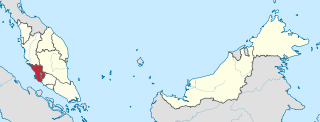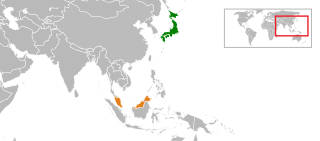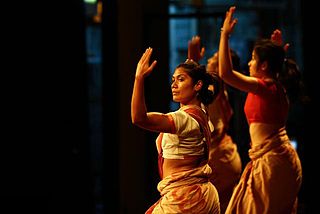
Malaysia is a modern concept, created in the second half of the 20th century. However, contemporary Malaysia regards the entire history of Malaya and Borneo, spanning thousands of years back to prehistoric times, as its history.

The demographics of Malaysia are represented by the multiple ethnic groups that exist in the country. Malaysia's population, according to the 2010 census, is 28,334,000 including non-citizens, which makes it the 42nd most populated country in the world. Of these, 5.72 million live in East Malaysia and 22.5 million live in Peninsular Malaysia. The population distribution is uneven, with some 79% of its citizens concentrated in Peninsular Malaysia, which has an area of 131,598 square kilometres (50,810.27 sq mi), constituting under 40% of the total area of Malaysia.

The Malaysian Indian Congress is a Malaysian political party. It is one of the founding members of the coalition Barisan Nasional, previously known as the Alliance, which was in power from when the country achieved independence in 1957 until the elections in 2018. The party was among the first to fight for Malayan Independence and is one of the oldest parties in Malaysia.

Selangor, also known by its Arabic honorific Darul Ehsan, or "Abode of Sincerity", is one of the 13 states of Malaysia. It is on the west coast of Peninsular Malaysia and is bordered by Perak to the north, Pahang to the east, Negeri Sembilan to the south, and the Strait of Malacca to the west. Selangor surrounds the federal territories of Kuala Lumpur and Putrajaya, both of which were previously part of it. Selangor has diverse tropical rainforests and an equatorial climate. The state's mountain ranges belong to the Titiwangsa Mountains, which is part of the Tenasserim Hills that covers southern Myanmar, southern Thailand and Peninsular Malaysia, with Mount Semangkok as the highest point in the state.

Malacca City is the capital city of the Malaysian state of Malacca, in Melaka Tengah District. It is the oldest Malaysian city on the Straits of Malacca, having become a successful entrepôt in the era of the Malacca Sultanate. The present-day city was founded by Parameswara, a Sumatran prince who escaped to the Malay Peninsula when Srivijaya fell to the Majapahit. Following the establishment of the Malacca Sultanate, the city drew the attention of traders from the Middle East, South Asia, and East Asia, as well as the Portuguese, who intended to dominate the trade route in Asia. After Malacca was conquered by Portugal, the city became an area of conflict when the sultanates of Aceh and Johor attempted to take control from the Portuguese.

Indian Singaporeans are Singaporeans of Indian or of general South Asian ancestry. They constitute approximately 9.0% of the country's citizens, making them the third largest ancestry and ethnic group in Singapore.

Hinduism is the fourth-largest religion in Malaysia. About 1.78 million Malaysian residents are Hindus, according to 2010 Census of Malaysia. This is up from 1,380,400 in 2000.
The Gujarati people, or Gujaratis, are an Indian ethnolinguistic group who reside in or can trace their ancestry or heritage to a region of the Indian subcontinent primarily centered in the present-day western Indian state of Gujarat. They primarily speak Gujarati, an Indian language. While Gujaratis mainly inhabit Gujarat, they have a diaspora worldwide. Gujaratis in India and the diaspora are prominent entrepreneurs and industrialists and maintain high social capital. Many notable independence activists were Gujarati, including Mahatma Gandhi, Muhammad Ali Jinnah and Vallabhbhai Patel.

The State of Penang, one of the most developed and urbanised Malaysian states, is located at the nation's northwest coast along the Malacca Strait. Unlike most Malaysian states, the history of modern Penang was shaped by British colonialism, beginning with the acquisition of Penang Island from the Sultanate of Kedah by the British East India Company in 1786. Developed into a free port, the city state was subsequently governed as part of the Straits Settlements, together with Singapore and Malacca; the state capital, George Town, briefly became the capital of this political entity between 1826 and 1832. By the end of the 19th century, George Town prospered and became one of the major entrepôts in Southeast Asia.

Tamil Malaysians, also known as Malaysian Tamilar, are people of full or partial Tamil descent who were born in or immigrated to Malaysia from Tamil Nadu, India and the Tamil regions of north-east Sri Lanka. The majority of 1.8–2 million people 80% of the Malaysian Indian populations in Malaysia were from Indian Tamil ethnic groups from Tamil Nadu and Sri Lanka. The bulk of Tamil Malaysian migration began during the British Raj, when Britain facilitated the migration of Indian workers to work in plantations. There are, however, some established Tamil communities from before British colonialism.
The term Gujarati Muslim is usually used to signify an Indian Muslim from the state of Gujarat in western coast of India. Most Gujarati Muslims have the Gujarati language as their mother tongue, but some communities have Urdu as their mother tongue. The majority of Gujarati Muslims are Sunni, with a minority of Shi'ite groups.
Immigration to Malaysia is the process by which people migrate to Malaysia to reside in the country. The majority of these individuals become Malaysian citizens. After 1957, domestic immigration law and policy went through major changes, most notably with the Immigration Act 1959/63. Malaysian immigration policies are still evolving.
The Punjabi diaspora refers to the descendants of ethnic Punjabis who emigrated out of the Punjab region in the northern part of the South Asia to the rest of the world. Punjabis are one of the largest ethnic groups in both the Pakistani and Indian diasporas. The Punjabi diaspora numbers around the world has been given between 2.5 and 10 million, mainly concentrated in Britain, Canada, United States, Western Europe, Southeast Asia, the Middle East, Australia and New Zealand.

Japan–Malaysia relations refers to bilateral foreign relations between the two countries Japan and Malaysia. The earliest recorded historical relation between the two nations are the trade relations between the Malacca Sultanate and the Ryūkyū Kingdom in the 15th century. Small numbers of Japanese settlers migrated to various parts of present-day Malaysia throughout the 19th century. This continued well into the 20th century, until relations reached an abrupt nadir with the rise of the Empire of Japan and its subsequent invasion and occupation of British Malaya and Borneo during World War II, during which the local populace endured often brutal Japanese military rule.

Malaysian Indians or Indo-Malaysian are Malaysian citizens of Indian or South Asian ancestry. They now form the third-largest group in Malaysia, after the Malays and the Chinese. Most are descendants of those who migrated from India to British Malaya from the mid-19th to the mid-20th centuries. Most Malaysian Indians are ethnic Tamils; smaller groups include the Malayalees, Telugus and Punjabis. Malaysian Indians form the fifth-largest community of Overseas Indians in the world. In Malaysia, they represent the third-largest group, constituting 7% of the Malaysian population, after the ethnic Malays and the Chinese. They are usually referred to simply as "Indians" in English, Orang India in Malay, "Yin du ren" in Chinese.

Malacca, officially the Historic State of Malacca, is a state in Malaysia located in the southern region of the Malay Peninsula, facing the Strait of Malacca. The state is bordered by Negeri Sembilan to the north and west and Johor to the south. The exclave of Tanjung Tuan also borders Negeri Sembilan to the north. Its capital is Malacca City, which has been listed as a UNESCO World Heritage Site since 7 July 2008. Malacca City is 148 kilometres southeast of Malaysia's capital city Kuala Lumpur, 235 kilometres northwest of Johor's largest city Johor Bahru and 95 km northwest of Johor's second largest city, Batu Pahat.

Singaporeans are the citizens and nationals of the sovereign island city-state of Singapore. Singapore is home to a people of a variety of ethno-racial origins, with the city-state itself being a multi-racial, multi-cultural, multi-religious, and multi-lingual country. Singaporeans of Chinese, Malay, Indian and Eurasian descent have made up the overwhelming majority of the population since the 19th century. The Singaporean diaspora is also far-reaching worldwide.

George Town, the capital city of the state of Penang, is the second largest city in Malaysia and the economic centre of the country's northern region. The history of George Town began with its establishment by Captain Francis Light of the British East India Company in 1786. Founded as a free port, George Town became the first British settlement in Southeast Asia and prospered in the 19th century as one of the vital British entrepôts within the region. It briefly became the capital of the Straits Settlements, a British crown colony which also consisted of Singapore and Malacca.

Malaysian Malayalees, also known as Malayalee Malaysians, are people of Malayali descent who were born in or immigrated to Malaysia from the Malayalam speaking regions of Kerala. They are the second largest Indian ethnic group, making up approximately 15% of the Malaysian Indian population. The bulk of Malaysian Malayali migration began during the British Raj, when the British facilitated the migration of Indian workers to work in plantations, but unlike the majority Tamils, the vast majority of the Malayalis were recruited as supervisors in the oil palm estates that followed the kangani system, and some were into trading and small businesses with a significant proportion of them running groceries or restaurants. Over 90% of the Malayalee population in Malaysia are Malaysian citizens.

The Javanese diaspora is the demographic group of descendants of ethnic Javanese who emigrated from the Indonesian island of Java to other parts of the world. The Javanese diaspora includes a significant population in Suriname, with over 13% of the country's population being of Javanese ancestry. Other major enclaves are found in Australia, French Guiana, Malaysia, the Netherlands, New Caledonia, Singapore, South Africa, and Sri Lanka.















